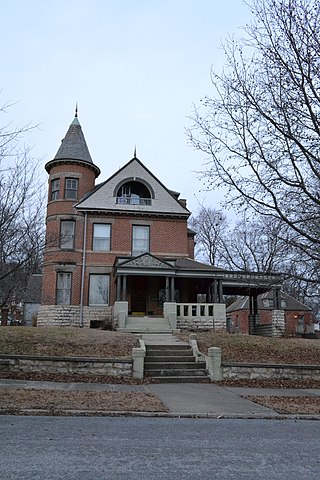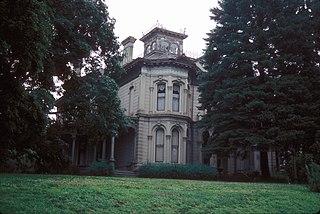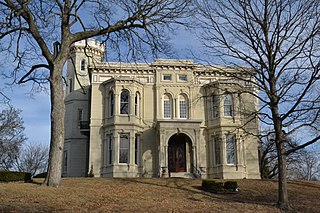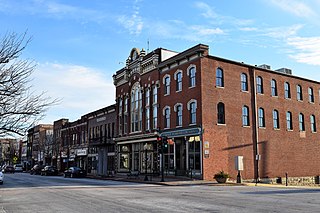Patee Town Historic District is a national historic district located at St. Joseph, Missouri. The district encompasses 71 contributing buildings and 1 contributing site in the Patee Town section of St. Joseph. It developed between about 1858 and 1939, and includes representative examples of Greek Revival and Italianate style architecture. Located in the district are the separately listed Patee House, a hotel that is a U.S. National Historic Landmark, and Jesse James House. Other notable buildings include the Morey Piro House (1910), Charles E. Herycele House (1903), R. L. McDonald Manufacturing Co. Warehouse (1899), Mrs. Pemetia Cornish Duplex, Fred Wenz Store Building (1903), Fire Station #5 (1939), German Salems Church, and Matthew Ziebold House (1895).

East Wheeling Historic District is a national historic district located at Wheeling, Ohio County, West Virginia. The district encompasses 300 contributing buildings and one contributing site, including the Monroe Street East Historic District. The district is primarily residential, developed in the late-19th and early-20th century. A number of popular architectural styles are represented including Greek Revival and Gothic Revival. Notable non-residential buildings include St. Joseph Cathedral (1926), former Hazel Atlas Company building, Scottish Rite Temple designed by noted Wheeling architect Frederick F. Faris (1870-1927), Elks Building, and YMCA (1906), also designed by Faris. The contributing site is Elk Playground. Also located in the district are the separately listed L. S. Good House, Charles W. Russell House, and Cathedral Parish School.

The Cathedral of St. Joseph is a Catholic cathedral in St. Joseph, Missouri, United States. Along with the Cathedral of the Immaculate Conception in Kansas City, Missouri it is the seat of the Diocese of Kansas City-St. Joseph. The Cathedral Church, rectory and convent are all contributing properties to the Cathedral Hill Historic District on the National Register of Historic Places. The school building and the auditorium do not contribute to the historical nature of the district.

The River Street Historic District is a national historic district that is located in Wilkes-Barre, Pennsylvania.

Edmond J. Eckel was an architect in practice in St. Joseph, Missouri, from 1872 until his death in 1934. In 1880 he was the founder of Eckel & Mann, later Eckel & Aldrich and Brunner & Brunner, which was the oldest architectural firm in Missouri prior to its eventual dissolution in 1999.

St. Mary Historic District is a national historic district located at Lafayette, Tippecanoe County, Indiana. In 1864, St. Mary's Catholic Church relocated from its original site at Fifth and Brown Streets to Columbia Street. With the move, many of the congregation also moved to this area. The Church became both a religious and social center for the neighborhood. Many of the homes date from the 1860s and 1870s and include fine examples of the Italianate, Greek Revival and Queen Anne styles as well as vernacular house types. Most of the people who built in this area were Lafayette businessmen. At 1202 Columbia Street James Ball, a local wholesale grocer left his name stamped into the front steps. Across the street is the James H. Ward House, who along with his brother, William, owned a local carpet and wallpaper business.

Chapel Hill Historic District is a national historic district located at Chapel Hill, Orange County, North Carolina. The district encompasses 46 contributing buildings, 2 contributing structures, and 2 contributing objects on the central campus of the University of North Carolina at Chapel Hill and surrounding residential sections of Chapel Hill. The district's buildings date from 1793 to the early-20th century and include notable examples of Classical Revival and Jacobean Revival architecture. Located in the district and separately listed are the Chapel of the Cross, Old East, building and Playmakers Theatre. Other notable contributing resources are the Davie Poplar, Old West (1822), South Building (1798), the Old Well, Person Hall (1797), Gerrard Hall (1822), New East, New West, the Joseph Caldwell Monument (1858), the Y.M.C.A. Building, Battle-Vance-Pettigre11 Dormitory (1913), Horace Williams House (1854), the Phillips Law Office, the Phillips House (1856), the Old Methodist Church (1853), Senlac, Hippol Castle (1920s), and Battle Park.

Farmville Historic District is a national historic district located at Farmville, Pitt County, North Carolina. The district encompasses 330 contributing buildings, 1 contributing site, and 2 contributing structures in the central business district and surrounding residential sections of Farmville. It includes buildings dated from about 1860 to 1942 and notable examples of Colonial Revival, Classical Revival, and Queen Anne style architecture. Notable buildings include the James W. May House, Fields-Rasberry House, Dr. David Morrill House, Warren Parker House, Nannie Smith House, First Christian Church (1910), Emmanuel Episcopal Church (1920), St. Elizabeth Catholic Church, Municipal Building (1928) possibly designed by Benton & Benton, Bank of Farmville (1921) designed by Benton & Benton, Pollard Auto Company Building, Paramount Theatre (1930s), J. Y. Monk Tobacco Warehouse, and East Carolina Railway Office and Freight Station.

Pine Hill Historic District is a national historic district located at Pine Hill, Ulster County, New York. It encompasses 125 contributing buildings, 3 contributing sites, 2 contributing structures, and 1 contributing object in the hamlet of Pine Hill. It developed between about 1800 and 1962 and includes notable examples of Greek Revival, Carpenter Gothic, Italianate, Stick Style, Second Empire, Queen Anne, Colonial Revival, Classical Revival, and Bungalow / American Craftsman architecture. Located in the district are the separately listed District School No. 14, Elm Street Stone Arch Bridge, Mill Street Stone Arch Bridge, Morton Memorial Library, and Ulster House Hotel. Other notable contributing resources include the John C. Loomis House, Methodist Episcopal Church, Benjamin Franklin Cornish House, Elizabeth Smith House (1876), Orchard Park House (1882), and "The Zepher".

West Washington Historic District is a national historic district located at South Bend, St. Joseph County, Indiana. It encompasses 330 contributing buildings in an upper class residential section of South Bend. It developed between about 1854 and 1910, and includes notable examples of Italianate, Greek Revival, and Romanesque Revival style architecture. Located in the district are the separately listed Morey-Lampert House, Oliver Mansion designed by Lamb and Rich, Second St. Joseph County Courthouse, South Bend Remedy Company Building, and Tippecanoe Place. Other notable buildings include the Bartlett House (1850), Birdsell House (1897), DeRhodes House designed by Frank Lloyd Wright, Holley House, Kaiser-Schmidt House, Listenberger-Nemeth House, Meahger-Daughterty House (1884), O'Brien House, Oren House, The People's Church (1889), St. Hedwig's Church, St. Patrick's Church (1886), St. Paul's Memorial United Methodist Church (1901), West House, and a row of worker's houses.

The Macon Historic District is a historic district in Macon, Georgia that was listed on the National Register of Historic Places in 1974 and was expanded in 1995. The original listing covered 587 acres (238 ha) and included 1,050 contributing resources; the increase added 101 acres (41 ha) and 157 contributing resources.

Dewey Avenue–West Rosine Historic District is a national historic district located at St. Joseph, Missouri. The district encompasses 37 contributing buildings and 1 contributing site in a predominantly residential section of St. Joseph. It developed between about 1880 and 1930, and includes representative examples of Italianate, Second Empire, Queen Anne, Colonial Revival, Tudor Revival, and American Craftsman style architecture. Notable buildings include the Marshall B. Stroud House (1890), John and Frank Whitman House (1890), Johanna Johnson House (1908), Frank Lacy House (1900), and a number of speculative houses built by Charles H. Nowland.

Harris Addition Historic District is a national historic district located at St. Joseph, Missouri. The district encompasses 288 contributing buildings and 1 contributing site in a predominantly residential section of St. Joseph. It developed between about 1866 and 1940, and includes representative examples of Colonial Revival, Tudor Revival, and American Craftsman style architecture. Notable buildings include the William Payne House (1889), W.C. Green Apartment Building, C.B. Powers House, the Parry-Motter House designed by architect Edmond Jacques Eckel (1845–1934), and a number of speculative houses built by George J. Englehart and W.H. Haynes.

Krug Park Place Historic District is a national historic district located at St. Joseph, Missouri. The district encompasses 28 contributing buildings and 1 contributing site in a predominantly residential section of St. Joseph. It developed between about 1888 and 1938, and includes representative examples of Italianate, Queen Anne, Colonial Revival, Tudor Revival, and American Craftsman style architecture. Notable buildings include the Henry Krug, Jr. House (1892) designed by architect Edmond Jacques Eckel (1845–1934),`A.V. Schaeffer House (1913), W.W. Van Sant House (1914), J.G. Schneider House (1899) by Eckel, Benton Quick House (1901), Mrs. W.B. Watkins House (1903), and George Ward House.

Kemper Addition Historic District is a national historic district located at St. Joseph, Missouri. The district encompasses 74 contributing buildings and 1 contributing site in a predominantly residential section of St. Joseph. It developed between about 1880 and 1950, and includes representative examples of Colonial Revival, Tudor Revival, and American Craftsman style architecture. Notable buildings include the Jacob Spencer House (1912), H. E. Hutchings House (1887), Fred Binz House, Thomas Moseley Duplex (1894), Plaza Apartments (1928–1929), Hickey-Fargrave House with alterations by architect Edmond Jacques Eckel (1845–1934),`C. E. Sprague House (1905) by Eckel, David Bartlett House (1900) by Eckel, and Samuel Nave House (1889).

Robidoux Hill Historic District is a national historic district located at St. Joseph, Missouri. The district encompasses 61 contributing buildings in a predominantly residential section of St. Joseph. It developed between about 1865 and 1909, and includes representative examples of Italianate, Second Empire, and Queen Anne style architecture. Located in the district is the separately listed Edmond Jacques Eckel House designed by architect Edmond Jacques Eckel (1845–1934). Other notable buildings include the Lemon House (1871), Donovan House, McKinney House (1887), Inslee House, Jonathan M. Bassett, and U.S. Weather Bureau Building (1909).

Museum Hill Historic District is a national historic district located at St. Joseph, Missouri. The district encompasses 248 contributing buildings in a predominantly residential section of St. Joseph. It developed between about 1860 and 1942, and includes representative examples of Italianate, Second Empire, Queen Anne, Tudor Revival, American Foursquare, and Bungalow / American Craftsman style architecture. Located in the district is the separately listed Robidoux School. Other notable buildings include the First Congregational Church (1890), Francis Street Methodist Church (1905), First Baptist Church (1896) designed by architect Edmond Jacques Eckel (1845–1934), United Presbyterian Church (1901), First Church of Christ Scientist (1905), First English Evangelical Lutheran Church (1913), and Queen of the Apostles Roman Catholic Church (1908) designed by Eckel.

Missouri State Capitol Historic District is a national historic district located at Jefferson City, Cole County, Missouri. It encompasses 122 contributing buildings in the central business district of Jefferson City. The district developed between about 1850 and 1950, and includes representative examples of Classical Revival, Late Victorian, Queen Anne, Mission Revival, and Modern Movement style architecture. Located in the district are the separately listed Missouri State Capitol, Lohman's Landing Building, Cole County Historical Society Building, Cole County Courthouse and Jail-Sheriff's House, Missouri Governor's Mansion, and Tergin Apartment Building. Other notable buildings include the St. Peter's Roman Catholic Church complex (1881-1883), Margaret Upshulte House, Broadway State Office Building (1938), Supreme Court of Missouri (1905-1906), U.S. Post Office and Courthouse (1932-1934), Lohman's Opera House, Missouri State Optical, First United Methodist Church (1900), Carnegie Public Library (1901), Temple Beth El (1883), and Joseph and Susie Kolkmeyer House.
Fayette Residential Historic District is a national historic district located at Fayette, Howard County, Missouri. The district encompasses 308 contributing buildings and 2 contributing structures in a predominantly residential section of Fayette. It developed between about 1832 and 1956 and includes representative examples of Gothic Revival, Italianate, and Queen Anne style architecture. Located in the district is the separately listed Coleman Hall. Other notable buildings include the Hampton L. Boon House / George Carson House, W. W. Blakemore House, John Sears House / John B. Clark House, McKinney Sisters House, Tully Chenowith House, Methodist Episcopal Parsonage, T. A. F. Mitchell House, Oliver H. P. Corprew House (1880s), Huntington Hall, A. F. Davis House (1880-1884), R. Lee Maupin House (1905), Mrs. John H. Farrington House, the Daly School (1924), the T. A. Grigsby Building, and St. Joseph's Catholic Church (1956).

North Third Street Historic District is a national historic district located at Louisiana, Pike County, Missouri. The district encompasses 61 contributing buildings, one contributing site, and contributing structure in a predominantly residential section of Louisiana. It developed between about 1843 and 1935 and includes representative examples of Greek Revival, Gothic Revival, Italianate, Queen Anne, Colonial Revival, and Bungalow/American Craftsman style architecture. Located in the district are the separately listed Louisiana Public Library and Luce-Dyer House. Other notable buildings include the William C. Hardin House, James H. Johnson House, Edward G. McQuie House, St. Joseph's Catholic Church (1874), and Frank Boehm, Jr. House.






















